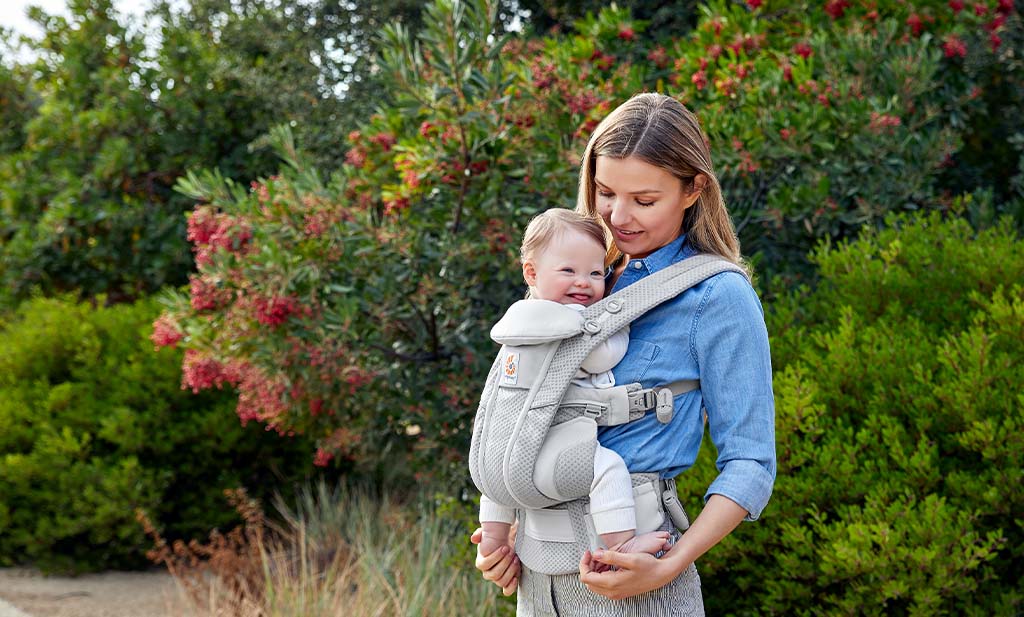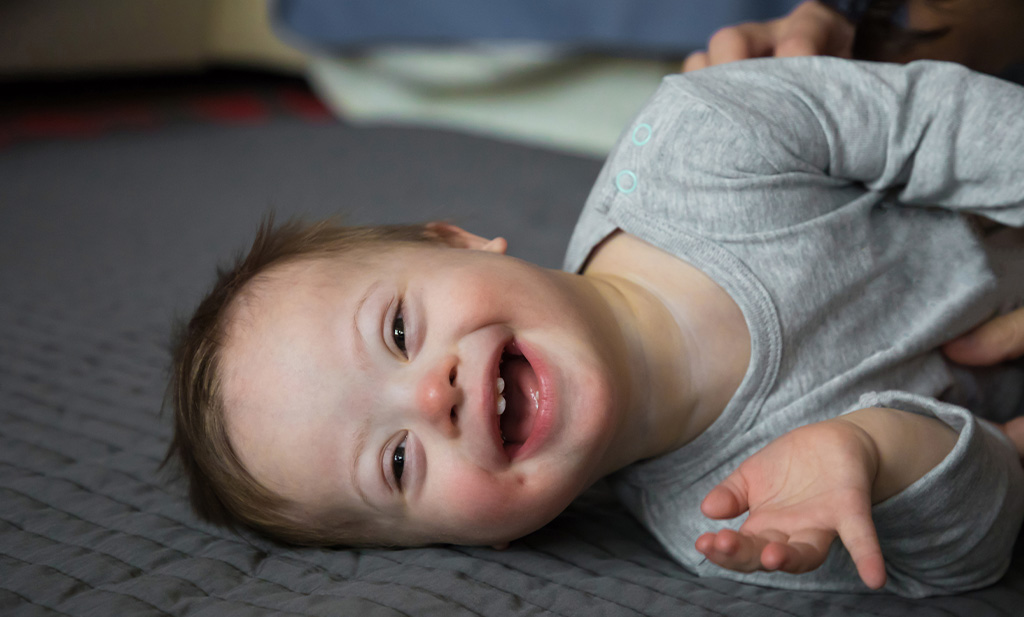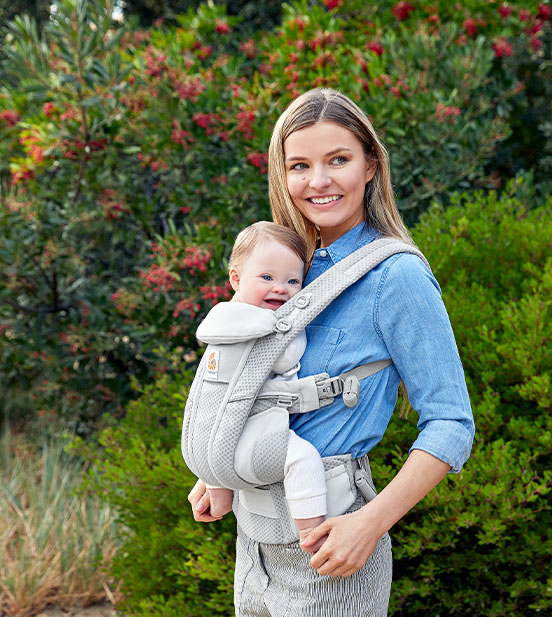
Humans are a carrying species. This means we have carried our babies since the beginning of time, across the most diverse cultures. And this also applies to children with disabilities too, including those with Down syndrome (also known as trisomy 21). A baby with Down syndrome has the same basic needs for love, security and cuddles as every child. Carrying them in a baby carrier or sling is a wonderful way to fulfil these needs and it is particularly beneficial to carry a baby with Down syndrome in a baby carrier. We would like to explain why this is the case in today’s blog post.
What is Down Syndrome?
Why do we differentiate between carrying a non-disabled child and carrying a child with Down syndrome? Simply because a baby with Down syndrome has different needs. Down syndrome, also known as trisomy 21, is a genetic disorder in which the 21st chromosome is not present twice, but three times. This additional genetic material alters the course of development and causes the characteristics associated with Down syndrome. One way to support a baby with Down syndrome’s development is to carry them in a baby carrier.
The importance of babywearing for a baby with Down syndrome
You might already know that babywearing in a baby carrier, sling etc. enables close physical proximity, which has a positive effect on the bond between parents and child. This in turn is important for the baby’s emotional and cognitive development. Babywearing can also have positive effects on physical development. For children with Down syndrome in particular, this can provide additional support during therapy.
Effects of babywearing on physical development
- Improvement of muscle tone and strength: Because a child with Down syndrome often has a slightly lower muscle mass and lower muscle tone than other children, babywearing can set the course early on for learning to stand and walk later on. This is because the baby carrier and sling activate and strengthen the muscles through movement and posture, thus improving the baby’s body tension. However, the frequency and duration of babywearing should be individually adapted to each baby – so please consult your doctor, midwife or babywearing counsellor.
- Promoting proprioception (your body’s ability to sense movement, action, and location) and posture control: Babies become more aware of their body in the carrier and are more aware of their posture. The close proximity to the body allows them to achieve and stabilise an upright posture, which can promote the development of their postural control and balance.
- Stimulation of sensory development: The gentle movement impulses and the proximity to mum or dad’s body provide a baby with Down syndrome in the baby carrier or sling with lots of sensory stimulation. In particular, the vestibular sensory impressions, which are responsible for balance and spatial orientation, are strengthened in this way.
- Promoting breathing and digestion: The upright posture and the movement impulses in the carrier can have a positive influence on the child’s breathing and digestion, which is important for healthy development.
- Joints in a central position: Children with Down syndrome often have hypermobile joints, especially the hip joint. This means that these children need more external support. A suitable baby carrier can provide support and prevent overstretching.

Effects of babywearing on mental and emotional development
- Strengthening the parent-child bond: Babywearing enables parents to respond more quickly to their baby’s needs and signals. This gives the baby a sense of security and trust and promotes co-regulation. The close physical proximity also contributes to the child’s emotional attachment. This is particularly important for children with Down syndrome, as they often have a somewhat delayed development and need more support.
- Calming and stress reduction: The closeness and security of being carried can calm a child with Down syndrome and reduce possible stress. This can help create a calmer and more relaxed atmosphere for parent-child bonding.
- Promoting communication and interaction: While babywearing, parents can easily communicate with their child, look them in the eye and respond to their signals. This promotes the development of the child’s communication and interaction skills.
- Promoting safety and self-confidence: The close bond and closeness during babywearing makes children with Down syndrome feel safe and secure. This can boost their self-confidence and give them the courage to explore their surroundings and have new experiences.
- Safe at home: As babies with Down syndrome often have to go to various doctors, babywearing has the advantage that the little ones feel safe and secure in the carrier. Even when unfamiliar things happen around them and they have to be in unfamiliar places for longer periods of time. The baby carrier becomes their home from home, so to speak.
- Active participation in social life: With a baby in a carrier, parents are more mobile and can actively participate in social life – even with a baby who needs extra closeness. But it’s not just important for parents to ‘socialise’. A baby with Down syndrome also wants to feel like they belong. In a baby carrier or sling, it can be everywhere, interact socially and be at the centre of life.
Which baby carriers are suitable for a baby with Down syndrome?
Carrying a baby with Down syndrome promotes their development, but requires special attention as they often have weak muscle tone and hypermobile joints. When choosing a baby carrier, whatever is comfortable for you and your baby and is good for both of you is the right choice. But: please always consult your doctor. And above everything it’s important that you make sure that the carrier you choose allows for an ergonomic position (spine supported in line with development and legs in M-position). The carrier should also be able to adapt to your growing baby and their needs, i.e. grow with them to keep supporting them at every stage of development. Here are some options:
- Baby carriers/comfort carriers: Ergonomic baby carriers are particularly practical as they are quick and easy to use and enable a close bond with your child. Make sure that the baby carrier is ergonomic, i.e. that it allows your baby to adopt a healthy posture in line with their developmental stage and that the legs are in the M position. It is advisable to start with a newborn carrier such as the Ergobaby Embrace and then later switch to a soft-structured carrier such as an Ergobaby Omni carrier.
- Woven slings, e.g. wrap-around cross slings: When tied correctly, woven slings can provide good support, especially for a child with Down syndrome, and offer close body contact and adaptability to the child’s needs. They enable an upright, healthy posture and support hip development. However, they require the correct tying method to suit the child and some practice in tying and knotting. A babywearing consultation can be very helpful here! Stretchy slings are usually not recommended for babies with Down syndrome, but may work in individual cases, depending on the advice given.
- Hip seat: If your child is at an active age (from 6 months) and constantly wants to be in your arms and then back down again the next moment, a hip seat is ideal for meeting your baby’s changing needs in a matter of seconds. With just one click, the hip carrier is put on and holds your child close to your body – without putting any strain on your hip, back or arm. And the best thing about it is that your baby can train their muscles well, but at the same time has stable support from below and support when squatting against your body. Please make sure that the hip seat fits your child correctly and avoid over-spreading the legs and slumping the upper body. They should also have full head control, i.e. holding the head independently. It is best to test with a babywearing consultant whether your baby is ready for a hip carrier or still needs some training in another baby carrier. A hip seat with a back panel is also very supportive.
- Ring slings: A sling fabric with two aluminium rings makes it particularly easy to carry your baby on your hips. If you are interested, please try them out with your babywearing consultant and make sure they provide good head support.

Choosing the right and suitable carrier for your baby with Down syndrome is very important so that you can support your little one’s development in the best possible way. It is important that you get help and support from a qualified professional. The choice, use of the carrier, duration and frequency of wearing should always be tailored to the individual child. Be sure to attend a babywearing consultation (you can find a list of lots of UK sling libraries here) and find out together what suits your family best. You may even be able to borrow the chosen baby carrier afterwards and get the okay from your doctor. They should always give their approval before you start wearing your baby. Sometimes the babywearing consultant can help with this too.
Carrying a baby with Down syndrome correctly
Whether you have a child with Down syndrome or not doesn’t really matter when it comes to the basic use of a baby carrier. The main thing is that it is ergonomic and you and your baby feel comfortable with it. You can work out how to position your baby correctly in the carrier together with a babywearing consultant and our many babywearing tips and instruction videos will also help you.
Slowly and gradually get your baby used to the carrier. Pay close attention to your little one’s reactions and gradually increase the duration of wearing. If your baby seems stressed or restless, take a short break. It’s best to integrate babywearing into your everyday life, use the carrier for everyday tasks such as household chores or an extra cuddle. This way, putting on and practising with the baby carrier is not an additional burden in your everyday life.
Positioning tips for carrying babies with Down syndrome:
- Ergonomic carrying position: legs well squatted and slightly spread, spine well supported according to age (upper body does not slump), head well supported up to the centre of the ear, or the nape of the neck once they can turn their head side to side and hold it for a few moments.
- Clear airways: Please make sure that your baby is well supported and that their upper body cannot collapse, especially when they fall asleep. Baby’s chin should never be pressed against their own chest and their face should always be clear of any straps or material.
- Avoid overspreading the legs: As children with Down syndrome often have lower body tension and hypermobile joints, the carrier should also fit the proportions of the parents well and not push baby’s legs too far apart. A babywearing consultant knows the ropes and can see what fits well.
- Good head support: Please always ensure baby’s head is appropriately supported! For baby carriers, please adjust the padded head support to fit; for woven slings, a small muslin cloth can be rolled up at the top of the outermost edge to support the head, but must not be restrictive.
- Support from the parents: Placing your hands on the outside of the child’s pelvis can provide additional support and encourage the child to sit upright.
- Hands to mouth: It is always important that your baby can bring their hands to their mouth – this also promotes uprightness.
- Bare feet: If possible (assuming the environment is warm), carry your baby with bare feet and keep touching them. This provides additional stimulation to activate the muscles. Otherwise, you can also stimulate the feet with socks if it is cold.
- Different carrying positions: Depending on baby’s age and development, keep changing the position (on your front, on your hip and on your back) and also offer world facing once baby is ready (at the earliest at 6 months). In this position, your little one can practise head control and actively use their hands and feet when interacting with you. But beware: this is hard work for them, so 10 minutes or less is enough! The hip carry position can also activate the rotational movement in the spine.
- Close enough to kiss: Make sure you can easily kiss baby’s head without craning your neck down.
- Babywearing consultant/doctor: Please have your carrier/wrap and its use checked by a babywearing consultant at regular intervals and always obtain permission from your child’s doctor beforehand.
Carrying a baby with Down syndrome in a baby carrier
Wearing a baby carrier or sling can be invaluable for a baby with Down syndrome and their family. It not only promotes physical development, but also strengthens the emotional bond between parents and child. Despite the potential challenges of raising a child with Down syndrome, a baby carrier allows you to live your life while meeting your baby’s needs.
Ultimately, babywearing is a simple but effective way to support the holistic development of children with Down syndrome. It is a valuable tool that can accompany families on their journey. So if you are one of these families, we would like to take this opportunity to invite you to try babywearing with your little one. It will enrich your everyday life. Guaranteed.
—————————————
Sources:
https://www.babyclub.de/magazin/babys-erstes-jahr/tragen-mit-downsyndrom.html
https://www.kindundkegel.de/themen/ratgeber/tragen-als-therapie.html
Dresdner TrageTage, Tagungsband 2011, Tragen von hypotonen Kindern



